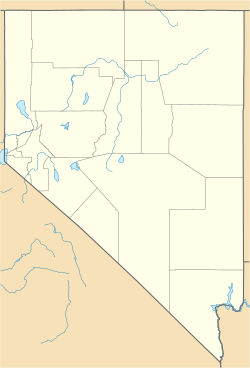Leeland, Nevada facts for kids
Quick facts for kids
Leeland
|
|
|---|---|
| Country | United States |
| State | Nevada |
| Counties | Nye |
| Founded | 1906 |
| Elevation | 2,380 ft (730 m) |
| Population | |
| • Total | 0 |
| GNIS feature ID | 856067 |
Leeland was once a small railway town in the Amargosa Valley in Nye County, Nevada. It was started in 1906. A year later, a train station opened there. This station helped move raw materials from a nearby mining town called Lee, California, by train.
Contents
History of Leeland
Leeland began in 1906. It was built along the Tonopah and Tidewater Railroad, which was a new train line that year. On October 15, 1907, a train station opened in Leeland. This station offered regular train service for both people and goods.
The station building itself opened a week later. It had three rooms and also housed an office for Wells Fargo. These buildings had dirt floors and no electricity or running water. This train station was the first one on the Tonopah and Tidewater Railroad line after crossing the border from California into Nevada.
According to an interview with Deke Lowe, the railway section foreman lived in Leeland. A foreman is a person who supervises a group of workers. Most foremen were usually Anglo-American (people of English-speaking European descent). The foreman's helpers, who were mostly of Mexican origin, lived with their families in small, one-room homes. Many of these helpers did not speak English. They often left Leeland within a year of arriving.
Leeland's Role in Mining
Leeland's station was important for moving raw materials. These materials came from the mining town of Lee, which was about 5 miles (8 km) west in California. Lee was a very busy mining town in 1906. A stagecoach line, which is like an old bus service, was set up between Lee and Leeland by C.E. Johnson.
As Lee grew, Leeland grew too. In 1909, Leeland had six or seven people living there. By 1911, its population grew to 25. On November 23, 1911, a post office was opened in Leeland, and George Railton became the postmaster.
Leeland was at its busiest in 1912. After that, it started to shrink because the mining economy in Lee collapsed. Leeland's post office closed on November 14, 1914. Even after the post office closed, Leeland was still a water stop for the railway. This meant trains could stop there to refill their water tanks. However, the town was slowly forgotten.
Leeland's railway station stayed open until April 1931. At that time, the station and other buildings were burned down by a person named Jack Behresin, who later died. The tracks of the Tonopah and Tidewater Railroad were removed in the early 1940s. Today, nothing is left of the old railway town.
Farming in Amargosa Valley
The area around Leeland in the Amargosa Valley was good for farming. There was plenty of groundwater that could be easily brought to the surface using wells. In Leeland itself, employees of the Tonopah and Tidewater Railroad grew vegetables and grains in their own backyards.
The railway company wanted to earn more money. They thought that if homesteaders (people who settled on and farmed public land) moved to the Amargosa Valley, they would use the train to transport their crops. Farms had already been started in other nearby places, like Ash Meadows and the Pahrump Valley.
In 1914 and 1915, railway officials visited the area. They wanted to see how good the land was for farming. To attract homesteaders, the Tonopah and Tidewater Railroad created a 10-acre (4-hectare) demonstration farm and dairy. This farm, called the T&T Ranch, showed what crops could be grown there. It was located about 5.5 miles (8.9 km) southeast of Leeland.
Challenges for Farmers
However, the T&T Ranch did not attract many homesteaders. Potential settlers were discouraged by the Homestead Acts. These laws required homesteaders to find enough surface water to grow crops on their land. This was difficult in a dry area like Nevada.
In 1919, the U.S. Congress passed the Pittman Underground Water Act. This law was supported by Nevada Senator Key Pittman and pushed for by the Tonopah and Tidewater Railroad. The law aimed to help develop dry land in specific parts of Nevada. It allowed the Secretary of the Interior to give out permits to drill wells. If someone found enough water to support at least a twenty-acre (8-hectare) crop field within two years, they could get 160 acres (65 hectares) of land.
After this law passed, five officials from the Pacific Coast Borax Company used it. This company owned the Tonopah and Tidewater Railroad. Their five homesteads were located around the T&T Ranch, forming one large area. In 1927, these land claims were officially approved, and the document was signed by President Calvin Coolidge.
The homesteaders then created the Leeland Water and Land Company. This was a holding company, which means it owned other companies or properties. Soon after, the owners gave the land rights to the Pacific Coast Borax Company.
The T&T Ranch continued to operate until the 1940s. It was then left empty because the Tonopah and Tidewater Railroad stopped running. The farms had not been very successful. A report in 1939 suggested that farming in southern Nevada struggled because farmers were too far from their markets.
Farming in the Amargosa Valley, outside of Ash Meadows, really took off about ten years after the railway closed. The T&T Ranch remained abandoned until 1946. That year, Gordon and Billie Bettles bought it. They ran the demonstration farm until 1964.
See also
 In Spanish: Leeland (Nevada) para niños
In Spanish: Leeland (Nevada) para niños


